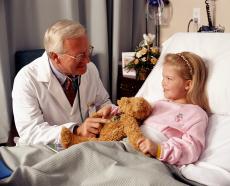 |
 |
 |
Other Health Topics:

-
Related Topics
-
Go Local
- Services and providers for Leukemia, Childhood in the U.S.
-
National Institutes of Health
- The primary NIH organization for research on Leukemia, Childhood is the National Cancer Institute
Leukemia is cancer of the white blood cells. It is the most common type of childhood cancer.
Your blood cells form in your bone marrow. White blood cells help your body fight infection. In leukemia, however, the bone marrow produces abnormal white blood cells. These cells crowd out the healthy blood cells, making it hard for blood to do its work. Leukemia can develop quickly or slowly. Acute leukemia is a fast growing type while chronic leukemia grows slowly. Children with leukemia usually have one of the acute types.
Risk factors for childhood leukemia include having a brother or sister with leukemia, having certain genetic disorders and having had radiation or chemotherapy. Treatment often cures childhood leukemia. Treatment options include chemotherapy, other drug therapy and radiation. In some cases bone marrow and blood stem cell transplantation might help.
National Cancer Institute
-
Childhood Acute Lymphoblastic Leukemia (PDQ): Treatment
 (National Cancer Institute)
(National Cancer Institute)
Also available in Spanish
-
Childhood Acute Myeloid Leukemia / Other Myeloid Malignancies (PDQ): Treatment
 (National Cancer Institute)
(National Cancer Institute)
Also available in Spanish
- What Is Childhood Leukemia?(American Cancer Society)
| Basics | Learn More | Multimedia & Cool Tools |
|---|---|---|
| Research | Reference Shelf | For You |
-
Overviews
-
Childhood Cancer: Leukemia(Nemours Foundation)
Also available in Spanish
-
Leukemia
 (Patient Education Institute) - Requires Flash Player
(Patient Education Institute) - Requires Flash Player
Also available in Spanish
-
Childhood Cancer: Leukemia(Nemours Foundation)
-
Latest News
- Survival Rates Improve for Kids with Blood Cancers(09/10/2008, HealthDay)
- Leukemia Tough on Down's Kids(09/03/2008, Reuters Health)
-
Diagnosis/Symptoms
- Acute Lymphoblastic Leukemia(College of American Pathologists) - Links to PDF
- Bone Marrow Aspiration and Biopsy(American Association for Clinical Chemistry)
- How Is Childhood Leukemia Classified?(American Cancer Society)
- How Is Childhood Leukemia Diagnosed?(American Cancer Society)
- Platelet Count(American Association for Clinical Chemistry)
-
Understanding Blood Counts(Leukemia & Lymphoma Society)
Also available in Spanish
- White Blood Cell Differential Count(American Association for Clinical Chemistry)
-
Treatment
- Blood Transfusion(Leukemia & Lymphoma Society)
- Immunotherapy(Leukemia & Lymphoma Society) - Links to PDF
-
Long-Term and Late Effects of Treatment for Childhood Leukemia or Lymphoma(Leukemia & Lymphoma Society) - Links to PDF
Also available in Spanish
-
MedlinePlus: Bone Marrow Transplantation
 (National Library of Medicine)
(National Library of Medicine)
Also available in Spanish
- New Approaches to Treatment(Leukemia & Lymphoma Society)
- Treatment of Children with Acute Lymphocytic Leukemia(American Cancer Society)
- Treatment of Children with Acute Myelogenous Leukemia(American Cancer Society)
-
Understanding Drug Therapy and Managing Side Effects(Leukemia & Lymphoma Society) - Large PDF file
Also available in Spanish
-
Prevention/Screening
- What Are the Risk Factors for Childhood Leukemia?(American Cancer Society)
-
Alternative Therapy
- Integrative Medicine & Complementary and Alternative Therapies As Part of Blood Cancer Care(Leukemia & Lymphoma Society) - Links to PDF
-
Coping
- Coping with Childhood Leukemia and Lymphoma(Leukemia & Lymphoma Society) - Large PDF file
-
Specific Conditions
- Chronic Myelomonocytic Leukemias (CMML)(Leukemia & Lymphoma Society)
-
JAMA Patient Page: Acute Lymphoblastic Leukemia(American Medical Association)
Also available in Spanish
-
Related Issues
-
Care for Children and Adolescents with Cancer: Questions and Answers
 (National Cancer Institute)
(National Cancer Institute)
Also available in Spanish
- Children Diagnosed with Cancer: Returning to School(American Cancer Society)
- Differences between Cancers in Adults and Children(American Cancer Society)
-
Magnetic Field Exposure and Cancer: Questions and Answers
 (National Cancer Institute)
(National Cancer Institute)
- What Happens After Treatment for Childhood Leukemia?(American Cancer Society)
- What Should You Ask Your Doctor about Childhood Leukemia?(American Cancer Society)
-
Young People with Cancer: A Handbook for Parents
 (National Cancer Institute)
(National Cancer Institute)
-
Care for Children and Adolescents with Cancer: Questions and Answers
- Tutorials Return to top
-
Financial Issues
- Insurance(Leukemia & Lymphoma Society)
- Insurance Issues (Cancer in Children)(Children's Oncology Group, National Children's Cancer Society)
- Patient Financial Aid(Leukemia & Lymphoma Society)
-
Clinical Trials
-
ClinicalTrials.gov: Childhood Leukemia
 (National Institutes of Health)
(National Institutes of Health)
-
ClinicalTrials.gov: Childhood Leukemia
-
Research
-
Childhood Cancers: Questions and Answers
 (National Cancer Institute)
(National Cancer Institute)
- What's New in Leukemia Research and Treatment?(American Cancer Society)
-
Childhood Cancers: Questions and Answers
-
Journal Articles
References and abstracts from MEDLINE/PubMed (National Library of Medicine)
- Article: Molecular mechanisms involved in chemoresistance in paediatric acute lymphoblastic leukaemia.
- Article: Reinduction platform for children with first marrow relapse in acute...
- Article: Survivor: what does it mean to be cured?
- Leukemia, Childhood -- see more articles
-
Dictionaries/Glossaries
- National Marrow Donor Program: Glossary(National Marrow Donor Program)
-
Directories
- Find a Pediatric Hematologist/Oncologist(American Society of Pediatric Hematology/Oncology)
-
National Cancer Institute Cancer Centers Program
 (National Cancer Institute)
(National Cancer Institute)
Also available in Spanish
-
Organizations
- American Cancer Society
- Leukemia & Lymphoma Society
-
National Cancer Institute

- National Marrow Donor Program
-
Newsletters/Print Publications
- Latest News(Leukemia & Lymphoma Society)
-
Statistics
-
Cancer Stat Facts: Leukemia
 (National Cancer Institute)
(National Cancer Institute)
- What Are the Key Statistics about Childhood Leukemia?(American Cancer Society)
-
Cancer Stat Facts: Leukemia
-
Children
-
Some Kinds of Cancer Kids Get(Nemours Foundation)
Also available in Spanish
-
Some Kinds of Cancer Kids Get(Nemours Foundation)
| Home | Health Topics | Drugs & Supplements | Encyclopedia | Dictionary | News | Directories | Other Resources | |
| Disclaimers | Copyright | Privacy | Accessibility | Quality Guidelines U.S. National Library of Medicine, 8600 Rockville Pike, Bethesda, MD 20894 National Institutes of Health | Department of Health & Human Services |
Date last updated: 11 September 2008 Topic last reviewed: 25 June 2008 |






